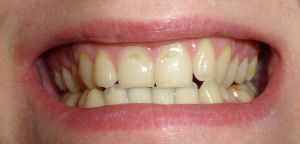 Erosion of tooth enamel is a non-carious disease, which is a gradual erasure of dental tissue. The disease often manifests itself on the more convex part of the outer tooth surface and has the appearance of a rounded defect.
Erosion of tooth enamel is a non-carious disease, which is a gradual erasure of dental tissue. The disease often manifests itself on the more convex part of the outer tooth surface and has the appearance of a rounded defect.
Everything begins with the defeat of the top layer of the enamel. At the same time, it becomes more faded, the bottom of the erosive lesion looks smooth and hard. A person experiences discomfort, due to the increased sensitivity of teeth, painful sensations arise during eating, cold air gets into it.
Over time, affected by erosion of the surface, change color, become brownish-yellow. In most cases, incisors of the upper jaw, located at the center and from the sides, as well as canines and small molars. If there is no timely treatment, the remaining teeth will be involved in the course of the lesion.
Contents
- What could be the cause?
- Consequences of erosion are deplorable
- Stages and phases of development of destruction
- Manifestations of erosion depending on stage
- Three stages of diagnosis
- Restorative therapy
- Easier to warn than to stop then
What could be the cause?
The reasons for the erosion of enamel are not fully understood, however, the main risk factors for the appearance of the disease can be identified:
- Mechanical damage to the tooth surface , due to the effect of paste, tooth powder or bleaching agents.
- Pathology of the endocrine system - thyroid disease. People, with disruption of the endocrine system, suffer from a lesion of tooth enamel twice as often.
- The chemical effect of , due to the use of acids contained in certain products, for example citrus, carbonated beverages.

- The increased load on the enamel with an incorrect bite or insufficient number of teeth in the mouth, thus the pressure during the chewing process is distributed unevenly.
- The use of medicines , containing in its composition ascorbic acid.
- Work on harmful production , where workers have to inhale mineral or metal dust.
Consequences of erosion are deplorable
Erosions are exposed mostly to middle-aged people. This process is characterized by a long-term course and can last from 10 to 15 years. It is possible to single out such consequences of the defeat of the tooth enamel:
- The wear of teeth is accelerated.
- During the exposure of the dentine , the tooth color of changes, they become darker.
- As the enamel of is worn, the sensitivity of the teeth of is exacerbated from the inner and outer surfaces, that is, discomfort is caused by touching both the tongue and the lips. Dentin is a soft tissue, so the pain will inevitably arise when air gets caught, chewing and the effect of food acid contained in food.
- Edge of anterior teeth may look more transparent .
The stages and phases of destruction
The disorder is classified not only in stages of development, but also in phases:
- The active phase is characterized by a progressive process of tooth decay, which causes excessive susceptibility of the teeth to the action of various stimuli. Enamel is destroyed very rapidly, the amount of erosion increases with each month.
- The stabilized phase is very slow. It is characterized by less pronounced pain sensations. This is due to the fact that as the defect is formed, the tertiary dentin is formed, which is a product of the vital activity of the pulp and acts as a protective barrier.
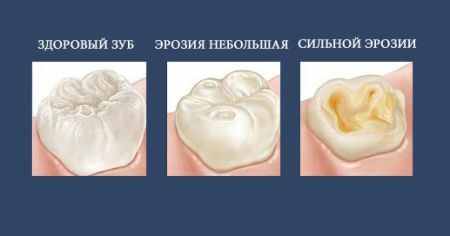
It is very important that in some cases the disease can transfer from one phase to another.
There are 3 stages of the development of the disease:
- initial , there is a lesion of a purely upper layer of enamel;
- average , enamel is affected so deeply that erosion reaches the dentin;
- deep , the enamel is completely affected, and the upper layer of dentin is also affected.
Manifestations of erosion depending on the stage
The process of the development of the disease is very rapid and dangerous, as the pathological abrasion of the hard tissues of the tooth develops on a par with erosion.
The disease is chronic, which progressively progresses over time and affects healthy teeth.
Symptomatic with progression of destruction:
- In the primary stage of , a loss in the brightness of tooth enamel is observed in the area of a certain area of the tooth surface. At this time, it is almost impossible to identify the process of erosion development. This can be done only due to the procedure for drying the surface of the tooth with an air jet or when applied to the affected area of iodine, in which case the erosive area will turn brown. Initially, the erosive defect will have an oval or round shape with a smooth bottom. Erosion has a whitish color. Painful sensations are absent.
- In the second stage of , uncomfortable sensations and discoloration of the affected area begin to appear.
- At the last stage of , there are noticeable painful sensations in the process of eating, brushing teeth. Changing pigmentation of affected areas. Brown spots appear on the tooth surface.
Three stages of diagnosis
Diagnosis is carried out during the dental examination:
- Detection of the localization of the erosive defect occurs by drying the tooth surface with an air jet and applying iodine.
- The process of differentiation of erosion from a wedge-shaped defect and caries of the primary stage. Erosion from caries will be distinguished by localization and the form of lesion, and also a smooth surface, with caries the surface becomes rough. The wedge-shaped defect will also differ in shape and location. It is found in the root of the tooth.
- In order for to identify concomitant pathologies of the endocrine system , an endocrinologist and gastroenterologist are examined, thyroid ultrasound is assigned, hormonal analysis of the thyroid gland is performed.
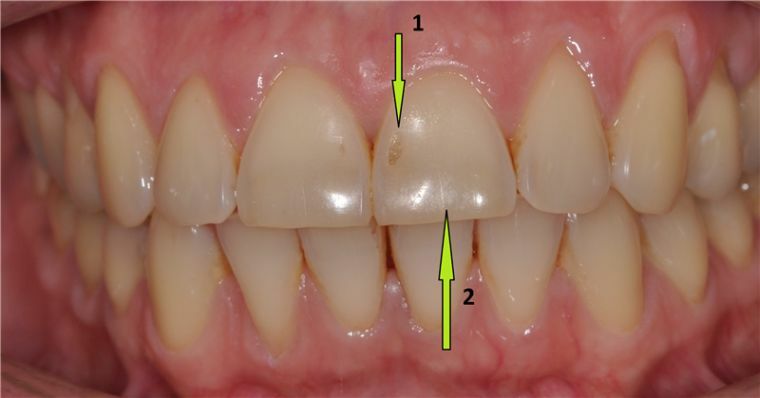
The photo shows where the enamel on the front teeth of the
was wiped. Rehabilitation therapy
Treatment for erosion of tooth enamel implies the appointment of local and general procedures for the transition of the disease from the active phase to the stable one. At the same time, the loss of hard dental tissues will be stopped.
If the enamel has already been erased, then they are assigned:
- Local therapy includes remineralization of - daily procedures for applications of fluoride and calcium-containing
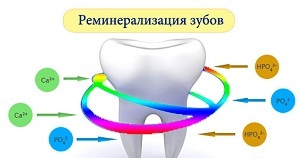 .The course lasts from two to three weeks. The final stage will be covering the surface of the teeth with fluorinated varnish. These procedures eliminate the increased susceptibility of enamel to the action of stimuli.
.The course lasts from two to three weeks. The final stage will be covering the surface of the teeth with fluorinated varnish. These procedures eliminate the increased susceptibility of enamel to the action of stimuli. - mineralization is performed using calcium electrophoresis .
- With a high level of damage to the hard tissues of the tooth and an explicit erosive defect, the tooth restoration procedure is performed using a light curing composite, a veneer or an artificial crown.
- General therapy implies prescription of medicines , with calcium and fluoride, as well as a complex of vitamins and minerals.
- Treatment of erosion in the stabilized phase assumes the continued use of the vitamin complex .Also, therapeutic methods at this stage will be aimed at eliminating the color change of eroded areas. For this, tooth polishing methods are used with a special paste, moderate bleaching and applying to the erosive areas of fluorine-containing lacquer and gel.
In case of erosion, tooth filling will not always be effective, as a violation of adherence of the filling material may occur, which can lead to the formation of a defect around the seal itself.
Easier to prevent than to stop
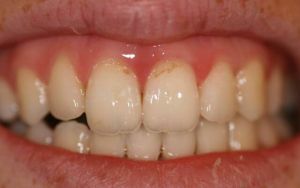 Unlike caries, the formation of erosion is not associated with non-compliance with hygiene measures to care for the oral cavity.
Unlike caries, the formation of erosion is not associated with non-compliance with hygiene measures to care for the oral cavity.
However, this disease can lead to the development of a carious process.
For prevention purposes, some rules should be followed:
- Reduce the consumption of foods and beverages, with high acidity, in order to reduce the effect of acid on the tooth surface.
- Drink beverages that contain acid in their composition, through the tube, do not delay the liquid for a long time in the mouth. It should be remembered that hot drinks affect the enamel much more than the cold ones.
- It is desirable after eating to eat something neutralizing acid or chewing gum without sugar.
- After using products with a high level of acidity, do not brush your teeth. It is better to conduct this procedure in an hour.
- Brushing your teeth correctly: do not press too hard, start cleaning from the inside, not from the outer surface.
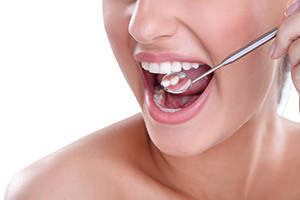
- Brush your teeth with a soft bristle brush, except ordinary paste, using a fluorine-containing paste with a low level of abrasion to prevent mechanical damage to the enamel.
- After eating, if it is not possible to brush your teeth, rinse your mouth with an antibacterial solution.
- Regularly undergo dental examination.
To prevent the development of the process of erosion of tooth enamel, treatment should be timely and of high quality. After transition from the active to the stabilized phase of the development of the disease, the patient must undergo systematic observation with a specialist.
